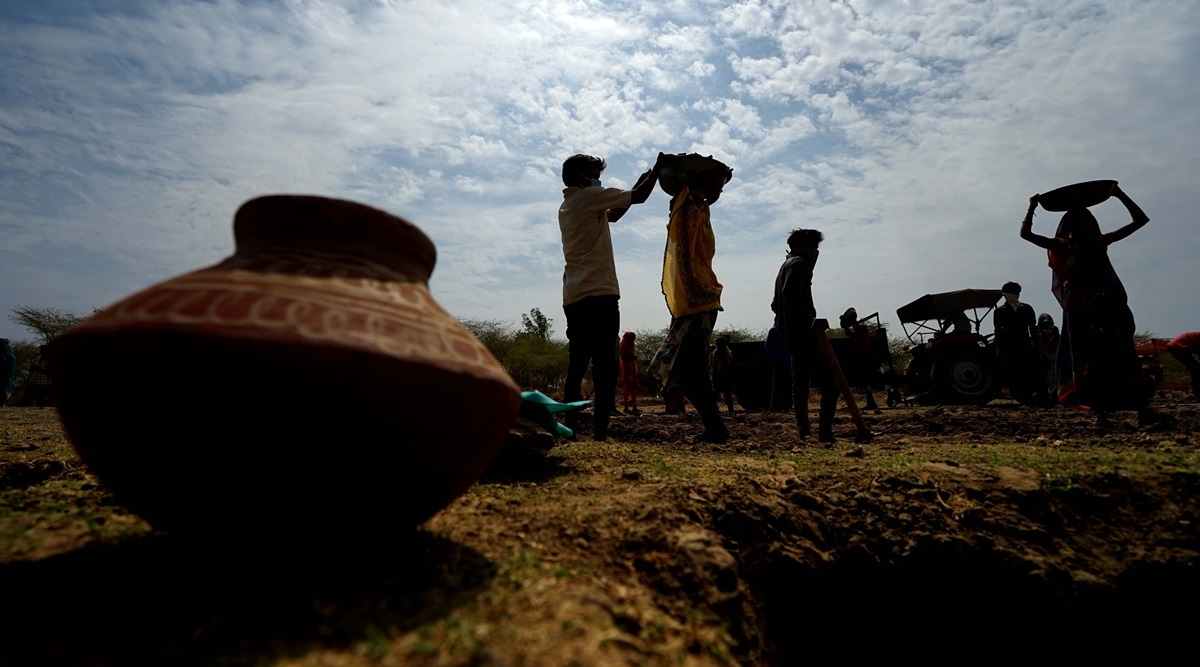 In Punjab, 1.03 lakh works (new plus spillover) have been taken up so far in the past five months. (Express Photo: Bhupendra Rana, File)
In Punjab, 1.03 lakh works (new plus spillover) have been taken up so far in the past five months. (Express Photo: Bhupendra Rana, File)Punjab has, for the first time, almost hit the target of expenditure on agriculture and allied works under the National Rural Employment Guarantee Scheme (NREGS). It has also seen a 15 per cent jump in expenditure on such works as compared to last year, amid the Covid-19 pandemic.
In 2016, the Centre had decided that to reach out to farmers, 60 per cent of expenditure under NREGS must be done on agriculture and agriculture allied works by creating productive assets directly linked to the same through the development of land, water and trees. Data sourced from the MGNREGA portal revealed that Punjab recorded 59.82 per cent expenditure on agriculture and allied works during this financial year from April to September 5, while this percentage was 45.02 per cent, 52.48 per cent, 56.31 per cent and 46.62 per cent in 2019-20, 2018-19, 2017-18, 2016-17, respectively.
Despite being a primarily agrarian state, Punjab was far from the target all these years. It is still lagging behind in the national level in the same category. At the all-India level, there is 74.99 per cent of expenditure on agri and allied works from April to September 5. Last year it was 66.39 per cent. There was 8.60 per cent growth with the return of lakhs of migrants to their native places, where they are getting employment under the MGNREGA.
In Punjab, 1.03 lakh works (new plus spillover) have been taken up so far in the past five months, of which 98,000 works are going on and only 5,028 could be completed to date from April to September 5.
Sources in the rural development and panchayat department revealed that there is a huge scope of spending on agriculture and allied works in Punjab, where 83 per cent area (over 41 lakh hectares) is under cultivation.
There are four categories of works undertaken as ‘agriculture and allied works’.
“This year, due to the pandemic, when more people are interested in working in their respective villages, several works are being designed with more focus on this. Works like cattle shelter and fodder troughs for cattle, creating infrastructure for promotion of fisheries, bio-fertilisers (NADEP, vermi-composting etc.),pucca storage facility for agriculture produce, micro, and macro irrigation projects, etc.,” said a block development and panchayat officer (BDPO) in Jalandhar, adding that there is no problem in making projects but at the ground level, there is a shortage of staff to execute them.
“In Punjab, where the water table is going down every year due to huge area under paddy crop, there is a huge scope for carrying out works related to water conservation and water harvesting structures to augment and improve groundwater. However, not much stress is being given to this except some projects Kandi belt (a sub-mountainous region of the state) while such works can arrest the depleted water table of Punjab with special focus on recharging groundwater including drinking water sources, renovation, and maintenance of irrigation canals and drain, traditional water bodies, desilting of water bodies, afforestation, tree plantation and horticulture in common and forest lands, road margins, etc.,” said another BDPO, adding that farmers can dig small ponds in a corner of their fields so as to get excess rainwater into these ponds, which will help in water re-charging and save the crop from getting damaged because of accumulation of water in the fields.
“But not the required number of such projects are being taken up,” the officer added.
Apart from this, for the promotion of livestock, cow shelter poultry shelter (brooder house), goat shelter and piggery shelter can also be constructed under MGNREGA and any NREGA worker who needs a cattle shed can get it constructed on their own as the government is providing both material and labour to them, said a district development and panchayat officer (DDPO).